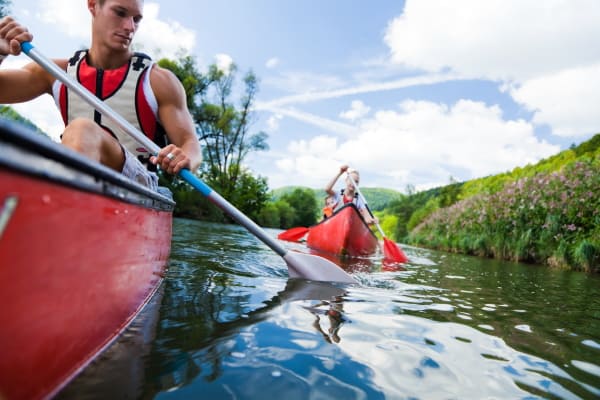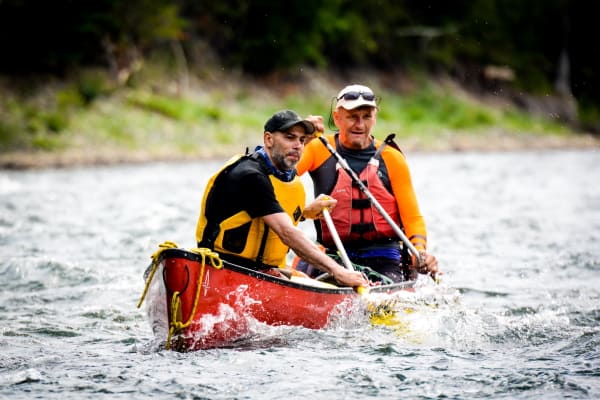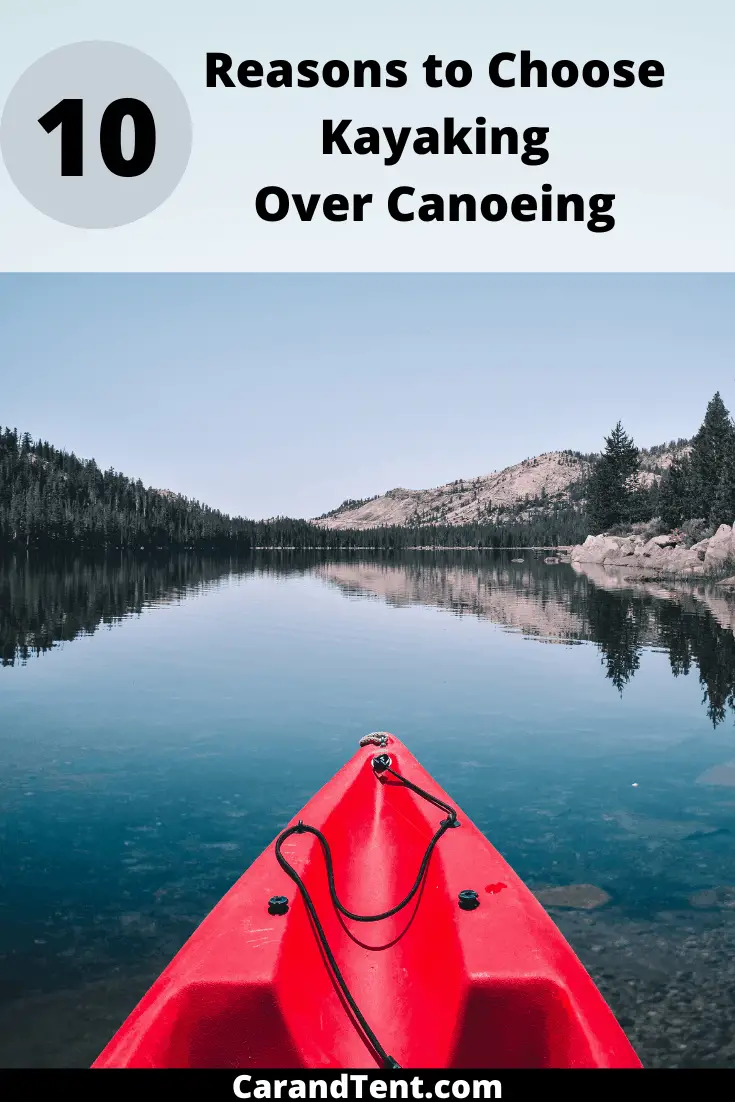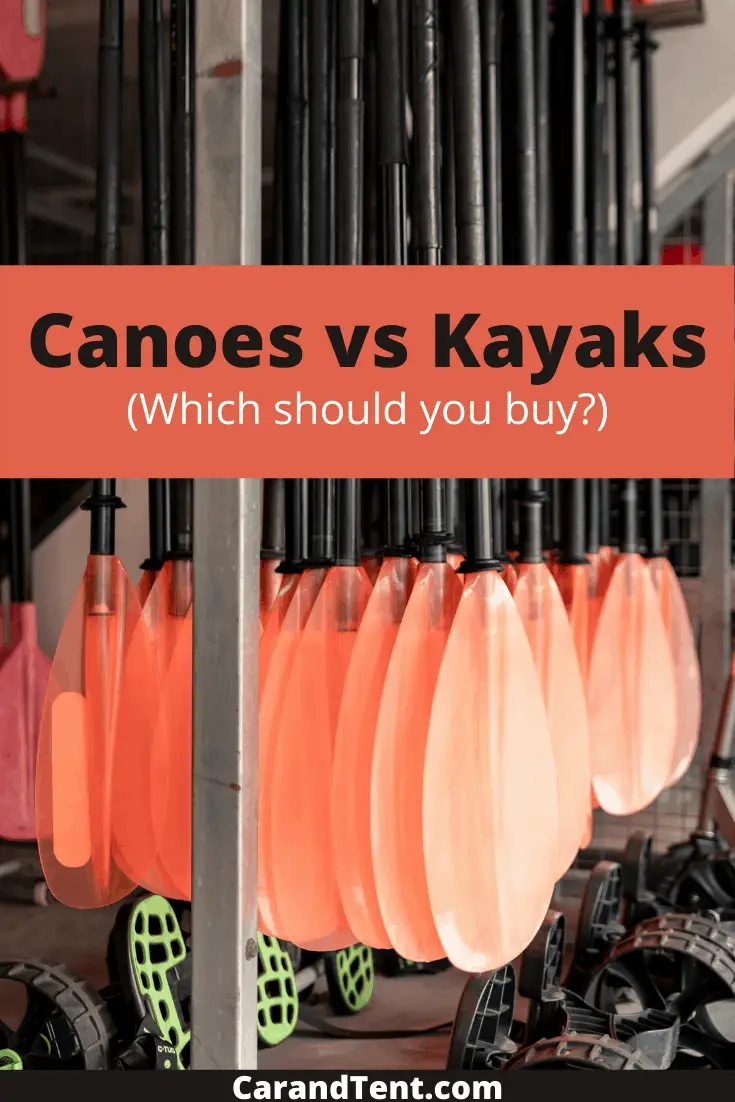
There are only so many weekends in a year. So how should you spend them, canoeing or kayaking?
In this post, we’ll talk about the pros and cons of canoeing vs kayaking so that you can decide for yourself.
Table of Contents
I’ve been canoeing and kayaking in both single and tandem crafts. Both can be fun and challenging and I’ve found that both of them have their place.
But first, let’s talk about the advantages each one has to offer.
Advantages of Canoeing Over Kayaking
You Get More Space
A canoe has a larger and deeper deck than a kayak. This gives you more space to bring gear and to move around. If you feel the need to do some light stretching after being on the water for a few hours, you won’t have any trouble doing it in your canoe.
Want to pack a cooler full of food and drinks? In this case, you’ll want to go canoeing instead of kayaking.
Are you planning on taking a traditional multi-day camping trip along the water? You’d be much better off going canoe camping vs kayak camping.
They’re Dryer
A canoe has higher sides than a kayak does. This helps to keep water out of it.
On top of this, the paddle design of a canoe is much less likely to bring water into the canoe when compared to the paddle design of a kayak. This might not seem like a big deal, but after a few hours on the water, you’ll notice that the water brought in from paddling can really be quite significant.
To put it into perspective, when I go kayaking I expect to get wet. In fact, I usually go kayaking in a bathing suit or quick-drying pants. When I go canoeing, on the other hand, I don’t intend to get very wet at all.
More Paddling Positions
A canoer has the option to kneel or sit when paddling their canoe. In fact, they can even kneel in front of their seat to achieve a sitting/kneeling position.
Kayakers don’t really have this option. In fact, a closed-deck kayak physically restricts the kayaker from doing anything but sitting.
People who tend to stiffen up over long periods of time might find that it’s much easier to sit in a canoe all day rather than a kayak. At least with the canoe, they’ll be able to switch from sitting to kneeling and vice versa throughout the day.
More Social
A canoe is without a doubt more social than a kayak. What I mean by this is that it’ss easier to carry a conversation in a canoe versus in a kayak.
In a canoe, the person upfront has the option to turn around and face his or her partner. Kayakers don’t have this option.
Also, canoes move more slowly on the water which makes it easier for the occupants to hear each other. Personally, I prefer tandem canoeing over tandem kayaking because I feel more in-tune with the person I’m paddling with.

Passenger Space
A large canoe can easily hold small passengers in the center of it. This really makes paddling with kids and pets a lot easier and more fun.
Want to take your wife and daughter out on the water? Get a large tandem canoe and your daughter can sit safely in the center of the canoe between you and your wife.
Thinking about taking your cat or dog to the lake? The center of a canoe can easily accommodate a dog, a cat, or any other small pet you’d like to take out with you.
More Stable
Canoes are usually much more stable than kayaks. This is especially true if you choose a wider canoe.
Inexperienced paddlers find this feature especially comforting as they’re much less likely to tip a canoe over versus a kayak. Also, people with kids or pets who’re prone to moving around will be much better off in a canoe.
A canoe is often so stable that you can stand up in it. This can be especially helpful when you want to get in and out of it. It can also be helpful for people who feel the need to stretch out from time to time.
Easier to Fish With
The increased stability and space make fishing much easier in a canoe than it is in a kayak. A canoe’s increased stability makes pulling in and unhooking a fish quicker and easier while the increased space makes storing the caught fish easier as well.
On top of this, the additional storage areas of a canoe make packing large tackle boxes much easier. I’ve found that when I fish from a canoe I can bring my tackle box and when I fish from my kayak I’m restricted to a fishing vest. This isn’t always a big deal, and I’ve caught plenty of fish with just the lures I was able to fit into my vest, but it is something to keep in mind when planning your trip.
Better For People With Mobility Issues
As we said earlier, it’s a lot easier to get in and out of a canoe compared to a kayak. It’s also easier to move a canoe paddle through the water than it is to move a kayak paddle.
While paddling a canoe, a person won’t have to turn their shoulders nearly as much as they will have to when paddling a kayak. When getting in and out of a canoe a person can step in standing which usually can’t be done in a kayak. These two facts make canoeing much more pleasant for people with mobility issues.
Easier to Get People to Go With You
Not everyone is comfortable on the water. This means that even if you have two kayaks it doesn’t mean you’ll be able to successfully be able to get your buddy/co-worker/significant other, or whoever else you want to take with you to actually go.
However, it’s usually much easier to convince someone to sit comfortably in the back of a canoe sipping on their favorite drink while you paddle them downstream than it is to get someone to learn how to paddle a kayak without soaking themselves. If you don’t already have someone lined up to go kayaking with, you might want to opt for a canoe instead.
Easier to Portage
Sometimes getting your boat into the water is the toughest part of the trip. Some of the best and most secluded spots for paddling require you to carry your craft through the woods. Doing so is usually much easier with a canoe.
The reason for this is that you can carry your canoe on top of both of your shoulders. Take a look at the video below to see this in action.
Advantages of Kayaking Over Canoeing
Increased Speed
Kayaks are a lot faster than canoes. Going from paddling a canoe to paddling a kayak feels like the difference between going from a pedal bike to a motorcycle.
This can make kayaking more exhilarating. It also makes kayaking a better choice for getting from point A to point B.
In fact, the increased speed gives you more options for traveling. For example, a kayak is fast enough that you can often use it to travel upriver. In the same water, you may find that a canoe just isn’t fast enough to travel in any direction other than downriver.
This means that if you pass your camping spot in a canoe, you’ll most likely have to land somewhere else. In a kayak, you can just turn around and paddle back up to it.
Better Handling
A kayak handles better than a canoe. To use another analogy again, a canoe is like driving a box van while a kayak is like driving a small car.
With a kayak, you’ll be able to turn quicker and paddle straighter than you can in a canoe. In fact, many kayaks have built-in rudders that will allow you to steer the kayak with the help of your feet.
Because of it’s better handling, people looking to navigate strong currents, rapids, or waves are much better off in a kayak than they are in a canoe.
Lower Pricing
Canoes and kayaks can both be purchased at reasonable prices as well as unreasonable prices. However, it is easier to find low-priced kayaks versus low prices canoes.
For example, you can buy a cheap canoe at Walmart for about $500.00. This is a pretty great price for a boat that can provide a lot of fun adventures.
However, you can get a cheap kayak at Walmart for less than $200.00 and a cheap kayak can provide just as many fun adventures as the cheap canoe.
Easier to Go Solo
A canoe can be somewhat tricky to handle by yourself. This is especially true for people who are new to the craft.
Kayaks, on the other hand, handle easily with just one person. The reason for this is the double-bladed paddle that the kayak uses. This type of paddle can quickly be used on either side of the boat while the single paddle and wide stance of a canoe make switching sides a bit more difficult to do.
Here is a video of what it looks like to paddle a canoe solo.
More Power Options
Kayaks have evolved a lot over the years and there is a multitude of ways to power them. You can buy kayaks that are powered by foot pedals, solar panels, trolling motors, and even sails.
You can also put sails and trolling motors on canoes, but I’ve yet to see them with foot pedals or small solar-powered motors. The advantage of the foot pedals is that you can hold a fishing rod while you move your kayak through the water. This is especially useful when you get your line stuck on something and have to move towards it to get it unstuck.
Easier to Transport
Kayaks are less bulky and sit on top of rooftops and on trailers much easier than canoes do. In fact, many RVers simply throw their kayaks inside of their RVs. A person with a bulky canoe doesn’t always have this luxury.
Also, a kayak can often be much shorter than a canoe. This makes it easier to toss in the back of a van or pickup truck. Shorter canoes, on the other hand, are harder to find and are often impractical.
Easier to Carry (Over Short Distances)
As we mentioned earlier, kayaks are hard to port. However, a kayak is easier to carry over short distances. The main reason for this is that they are less bulky. You can grab a kayak with one hand and carry it next to you like a large suitcase. Also, kayaks are lighter so you’ll usually be able to carry your solo kayak by yourself without any trouble.
One nice thought to keep in mind is that both kayaks and canoes can take advantage of small dollies. These dollies make it easy for anyone to wheel their canoe or kayak down to the water’s edge.
Handles Capsizes Better
Flipping over an overturned kayak is easy. You just grab one side of it, flip it over, and jump back on. I’ve launched kayaks into the ocean on stormy days and was still able to quickly flip the kayak over in between waves.
Conversely, flipping over a capsized canoe can be difficult. This is especially true if you’ve loaded all of the extra space down with gear. You’ll probably want to practice righting a canoe in calm waters before heading out into anything choppy, but with a kayak, you won’t really need to take this step.
Better in Rough Water
Kayaks can be built in many different ways. Some are longer to handle sea kayaking, some are shorter to handle white water rapids, others are more narrow for racing.
At the end of the day, a kayak’s superior maneuverability and speed, as well as its ability to handle, capsizes make it perfect for all types of waters. For this reason, your only choice for some waters will be a kayak.
Less Bugs (Usually)
Kayaks can take on rougher waters with heavier winds. This gives you the option to venture out into bug-free waters.
Canoes don’t always give you this option. When you’re on a canoe, you’ll most likely be on still waters that are prone to mosquito and fly infestations.
Choosing Between a Kayak and a Canoe
My advice would be to plan on trying out both of them. Rent or buy a canoe for canoe camping trips, tandem trips, and relaxing still-water excursions. In the canoe, you’ll be able to slowly float down the river or hand out on the lake without a lot of effort on your part.
Choose a kayak when you want to experience fast-moving rivers, large lakes, and upriver paddling. You’ll get to move faster through the water and you may even get a nice workout out of it.



